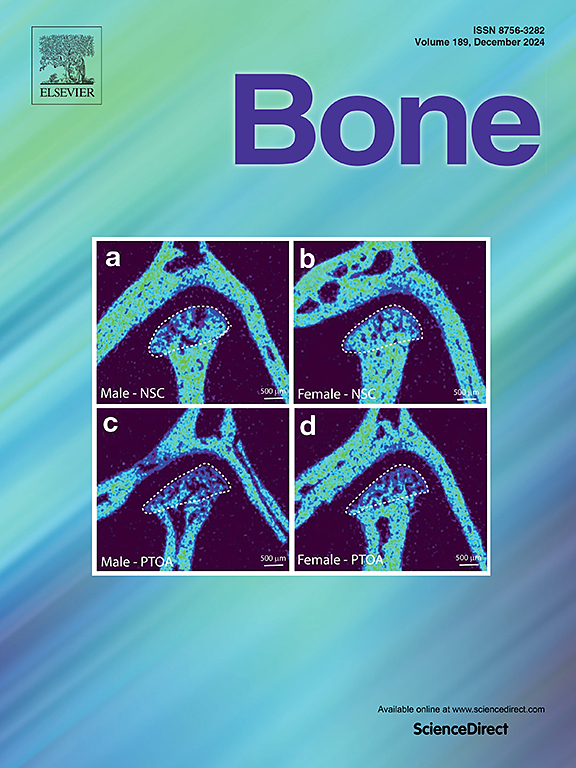Stress fracture of bone under physiological multiaxial cyclic loading: Activity-based predictive models
IF 3.5
2区 医学
Q2 ENDOCRINOLOGY & METABOLISM
引用次数: 0
Abstract
While it is known that excessive accumulation of fatigue damage from daily activities contributes to fracture, a model of bone failure under physiologically relevant multiaxial cyclic loading needs to be developed in order to develop effective management strategies for stress or fatigue fractures. The role of strain-induced damage from repetitive loading is a strong candidate for such a model, as cycles of mechanical loading leading to failure can be measured directly. However, this approach has been limited by the restrictions of uniaxial loading models, which often overestimates the fatigue life of bone and suggests that bone will only break well beyond the realistic limits of exercise. To address this gap and develop a physiologically relevant model, our study leverages the power of four commonly used engineering failure criteria as a model for multiaxial loading using a cohort of human tibiae from cadaveric donors (age range 21–85 years old). Four failure criteria (Von Mises, Tsai-Wu, Findley critical plane, and maximum shear strain) were found to be effective in vitro models of tibial fracture when age groups of donors were combined (r2 > 0.84) and stratified (younger: 21–52-years-old versus older: 57–85-years-old) (r2 > 0.83) (p < 0.001). Each failure criterion displayed distinctly lower fatigue curves for the older age group. The maximum shear strain model was used to determine the efficacy of this approach to predict fatigue fractures in humans using published in vivo data from human volunteers. Consistent with in vivo observations in general population, the model demonstrated failure at 5000 to 200,000 loading cycles depending on activities such as jumping, sprinting, and walking, with a 3-fold reduction of fatigue life in older donors. These findings dramatically improve estimates of fatigue life under repetitive loading and demonstrate how age-related changes in bone significantly increase its propensity for fatigue-induced fractures.
生理多轴循环负荷下的骨应力性骨折:基于活动的预测模型
众所周知,日常活动造成的疲劳损伤过度累积会导致骨折,但为了制定有效的应力性或疲劳性骨折管理策略,还需要建立一个与生理相关的多轴循环负荷下的骨破坏模型。重复加载造成的应变诱导损伤是此类模型的有力候选者,因为导致破坏的机械加载周期可以直接测量。然而,这种方法一直受到单轴加载模型的限制,因为单轴加载模型通常会高估骨骼的疲劳寿命,并认为骨骼只有在远远超出实际运动极限的情况下才会断裂。为了弥补这一不足并建立一个与生理相关的模型,我们的研究利用了四种常用的工程失效标准作为多轴加载模型,并使用了一批来自尸体捐献者(年龄范围为 21-85 岁)的人类胫骨。研究发现,当供体年龄组合并(r2 > 0.84)和分层(年轻:21-52 岁与年长:57-85 岁)(r2 > 0.83)时,四种失效标准(Von Mises、Tsai-Wu、Findley 临界平面和最大剪切应变)是有效的胫骨骨折体外模型(p
本文章由计算机程序翻译,如有差异,请以英文原文为准。
求助全文
约1分钟内获得全文
求助全文
来源期刊

Bone
医学-内分泌学与代谢
CiteScore
8.90
自引率
4.90%
发文量
264
审稿时长
30 days
期刊介绍:
BONE is an interdisciplinary forum for the rapid publication of original articles and reviews on basic, translational, and clinical aspects of bone and mineral metabolism. The Journal also encourages submissions related to interactions of bone with other organ systems, including cartilage, endocrine, muscle, fat, neural, vascular, gastrointestinal, hematopoietic, and immune systems. Particular attention is placed on the application of experimental studies to clinical practice.
 求助内容:
求助内容: 应助结果提醒方式:
应助结果提醒方式:


